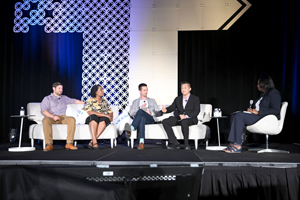
AACRAO's 2019 Technology & Transfer Conference kicked off with an exciting and wide-ranging opening plenary presentation. The four-person panel "Technological Innovation and Trends in the Higher Education Space " brought together technology
strategists to discuss innovation, entrepreneurship, and the future of technology in the education sector. Panelists included Andrew Magliozzi, CEO and Cofounder of AdmitHub, Duana Malone, Owner of Tech Queen Systems, Kevin Martin from
Parchment, and Jeffrey Yan, Co-Founder and CEO of Digication. AACRAO Associate Executive Director Tina DeNeen moderated.
The conversation was driven by questions submitted by the audience ahead of time, including:
How do you identify opportunities for innovation?
Malone: With my consulting firm, the importance of participating in technology groups and meetups is clear to understand what’s new in the field.
Magliozzi: AdmitHub’s main feature is our automated chatbot to help pinpoint student needs. We use our AI system to survey the students--once we complete the task, the automatic response is “If there’s anything else I could
do, what is it?” We then use data from that to move forward.
Yan: Higher education is all about consuming knowledge and creating products from that. Look at what the students are creating, and you’ll know exactly what sort of innovation they’re craving. We use Digication’s e-Portfolio
tool to do just that.
How does new technology impact students?
Yan: It eases their workload. An example is an institution we worked with that used to have students write reflections after submitting each paper. Eventually they started using an audio tool to record verbal reflections, which raised their submission
rate by a substantial amount.
Magliozzi: I would say a lot of students don’t even know that they’re interacting or living with new technology when looking at it from an institutional point of view. An example is the usage of new retention tools by the institution
that keeps the student there.
What are your thoughts on blockchain?
Magliozzi: I think it's about 5-10 years away from being viable.
Martin: I disagree, I think it’s sooner than 5-10 years. The question is would students be good stewards of their own data? That’s a conversation higher education needs to be having, especially since Generation Z seems to be more
intuitive with privacy. Sure they post their lives on social media, but have the foresight to have different Instagram accounts for privacy purposes--also known as “finstas.”
Yan: We are not ready from a portfolio standpoint. We’ve worked with digital badging systems with mixed results, so I can only imagine what it’d be like with blockchain.
How do you preserve human relationships in such a high tech environment?
Malone: Practice by interaction; don’t let it be voided out for a technological replacement.
Magliozzi: With the chatbots, students are pretty vulnerable. I find that they are more willing to share with the robot since they feel like they’re not being judged, so in a way the technology is preserving the human aspect of our interactions.
Martin: The people you work with value face time with you, not technology. Take your staff on walks during meetings, and find ways to be more engaging.
Yan: On a different note, we need to ask ourselves what the role of technology plays into mental health. I think we could address a whole host of issues that crop up with technology from that point of view.